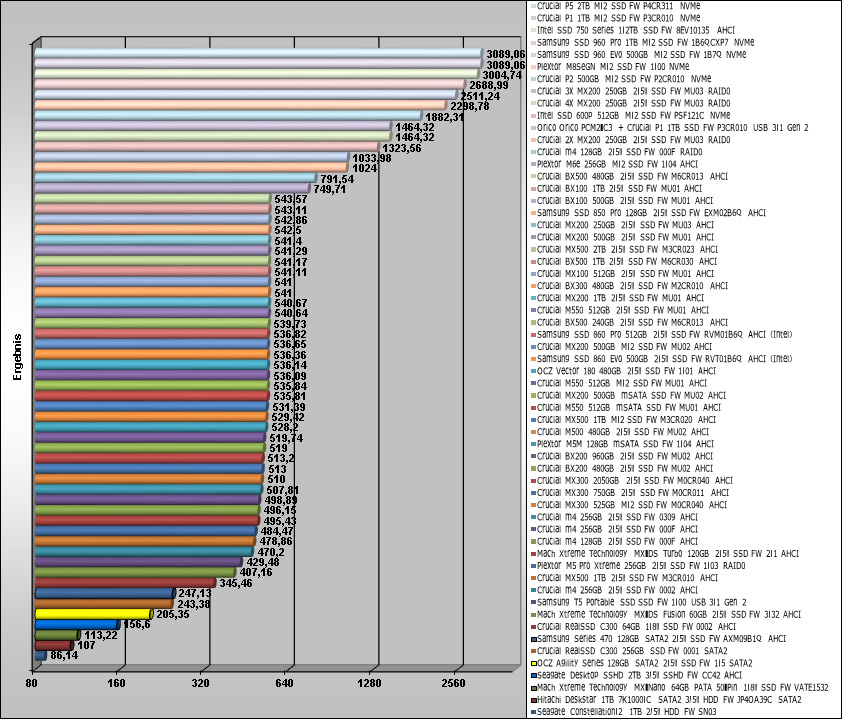
Let us continue with the benchmark results. SATA2 drives are currently tested with an ASRock M3A790GXH/128M motherboard and SATA3 drives are currently tested with an ASRock 890GX Extreme3 motherboard. At present, Microsoft Windows 7 Ultimate Edition is used as the operating system.
The SSD drive speed was examined and compared with the following benchmark software:
AS SSD Benchmark 1.4.3704.27281 – Download
ATTO Disk Benchmark v2.46 – Download
CrystalDiskMark 3.00 – Download
HD Tach 3.040 – Download
SiSoftware Sandra 2010c – Download
The SSD benchmark values offers a very good reference point of the maximal possible reading and writing performance, the speed with smaller files and the respective access time.
The 256GB Crucial drive achieved in AHCI mode directly after TRIM an enormously high sequenzielle read and write performance.
In the IDE mode and after a few reading and writing cycles however in spite of correct C400 SSD Alignment only slow and fluctuating reading rates were reached. The performance was some times so slow, that we assumed a defective SSD. Directly after the TRIM the performance went back to the default fast values. According to Crucial support this is attributed to the new NAND memory, which has a higher density of 8K with the 256GB m4 SSD and not the 4K block size as with the smaller SSDs or the C300 RealSSD.
The 256GB Crucial drive achieved above all an amazing high sequential read rate. With approximately 275 MB/s, the maximum transfer rate of the Serial ATA 2.0 interface was exceeded, so that a SATA3 interface is really the best choice for this SSD. The write performance in IDE mode was approximately 241 MB/s, which is much faster than the 256GB 2.5″ C300 RealSSD with about 211 MB/s previously tested. The overall score reached also in IDE mode very good 291 points, because for example the OCZ Agility 120GB SATA2 SSD reached only 138 points and the 256GB C300 SSD reached 290 points.
Here is a Snipping screenshot of the AS SSD benchmark results (SATA3 IDE):
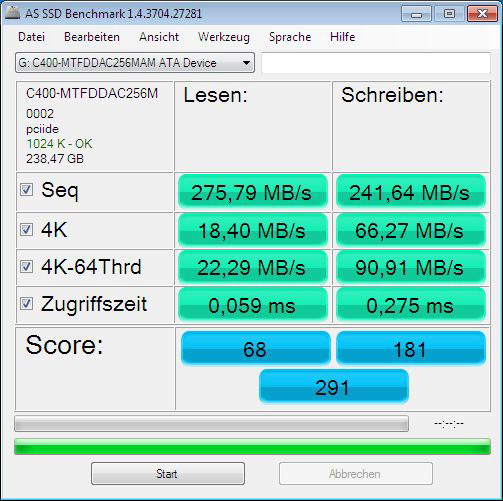
In AHCI mode also another result beneath the read performance was much higher than in the IDE mode and that is the important value “4K-64Thrd”. 4K means that small 4K blocks are read and/or written and with the 4K 64Thrd this is distributed on 64 Threads at the same time. Thus the benchmark program simulate for example a typical program start. Since the weighting of this value is very high in the AS-SSD benchmark tool,the total score in AHCI mode is with 530 points much higher than the previous one in IDE mode. In AHCI mode the Crucial m4 256GB reached even 410MB/s read- und 266MB/s writeperformance, which currently beats the highest score in our reviews.
Hint: Who think now about changing its SATA port in the BIOS from native IDE and/or legacy IDE to AHCI, should change first for example (if possible) only one part of the SATA port, where the drive with the operating system is not installed. Because if one like to save the new Windows installation, one must install the hard disk controller driver before changing SATA mode from IDE to AHCI – alternatively there are also Registry entries for it. If you like to upgrade from HDD to SSD, you should not copy the content 1:1 only with a tool like Norton Ghost or Acronis Backup. It is better to install a fresh Windows7 or adjust at least the SSD Alignment. We help you with questions to this topic or all other PC related questions at any time 24/7 in our PC Forum.
Here is a Snipping screenshot of the AS SSD benchmark results (SATA3 AHCI):
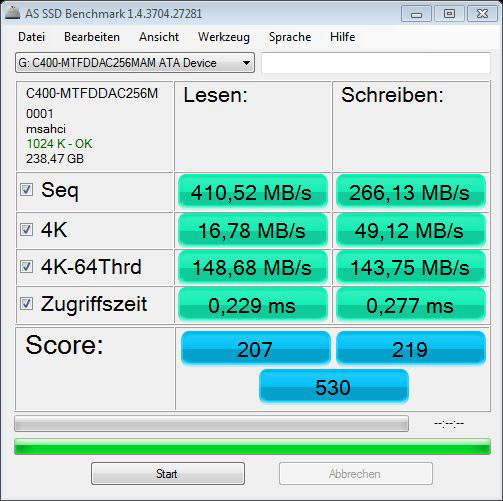
Here is a Snipping screenshot of the AS SSD iops results to measure the input/output speed (SATA3 IDE):
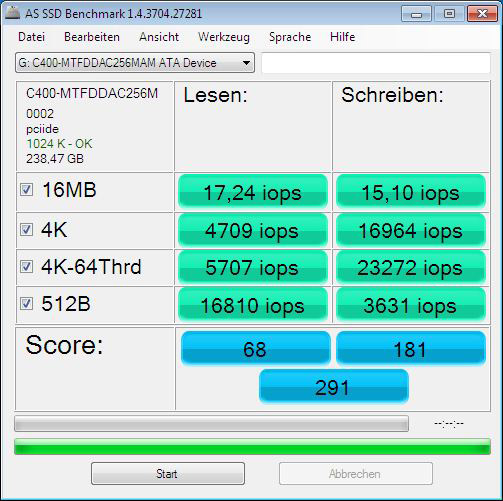
And here is a Snipping screenshot of the AS SSD iops results to measure the input/output speed, with a drastic rise in AHCI up to the manufacturer data of approx. 50k/40k (SATA3 in AHCI mode):
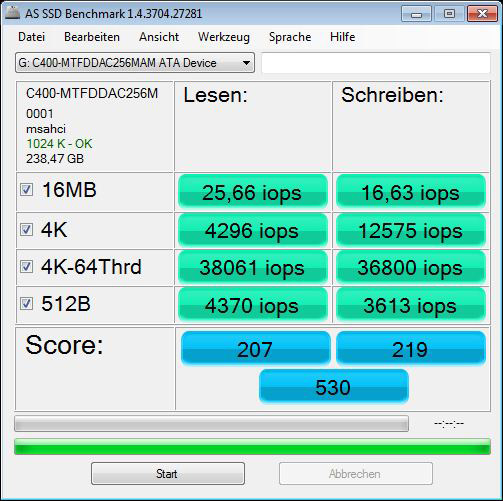
The comparison of the AS SSD benchmark results is extended with each new HDD/SSD test. Here we see several SSDs in comparison to the Crucial m4 256GB 2.5″ SSD in IDE and in AHCI mode, whereby the diagram is updated shortly with new SSDs. Currently, the Crucial m4 256GB SSD is clearly at the top, followed by the Crucial RealSSD C300.
Here is a comparison of the AS SSD benchmark values, which are getting updated with soon coming drives:
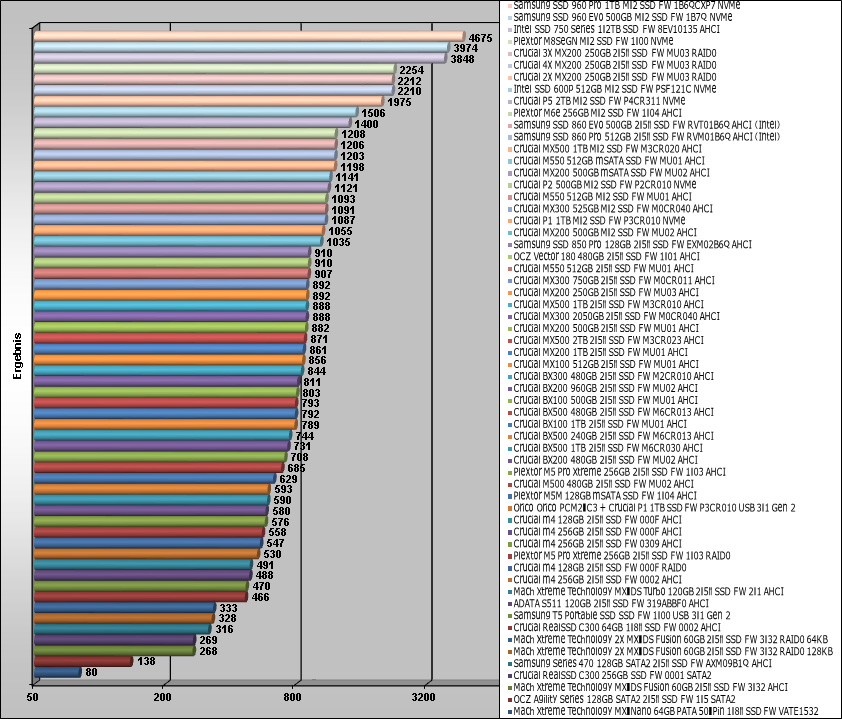
The ATTO disk benchmark values gives a very good overview about the write and read rate on different file sizes. Here we see once again a huge difference between legacy IDE and AHCI, especially with this SSD. The read and write performace is in legacy IDE mode nearly identically, but in AHCI mode we see a much higher read performance.
Here is a Snipping screenshot of the ATTO Disk benchmark values (SATA3):
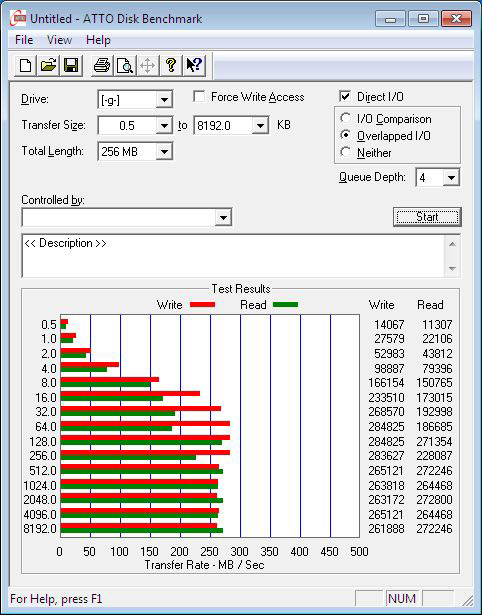
Compared to this result, the read performance in AHCI mode is significantly increased starting with a transfer size of 32k. Here we see can see a very good comparison of the conventional native IDE mode and the modern AHCI mode, which offers beside the higher performance also advantages like e.g. the support of NCQ (Native Command Queuing) or Hot-Plug.
Here is a Snipping screenshot of the ATTO Disk benchmark values (on SATA3 AHCI):
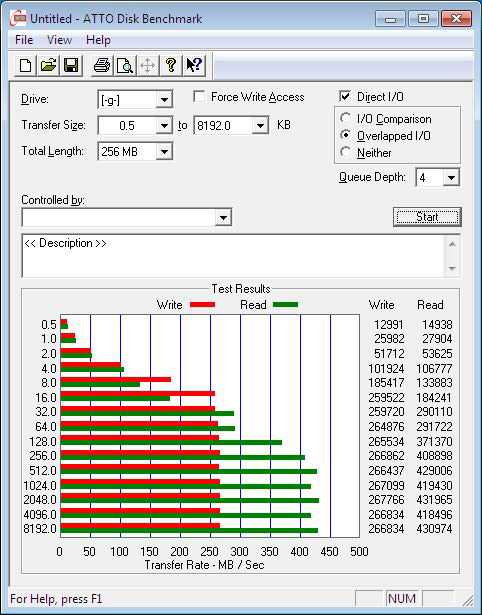
The ATTO disk benchmark values are compared with a small transfer size of 32KB and a large transfer size of 8192KB. The bar chart already shows a first comparison to the Hitachi Deskstar 7K1000.C 1TB hard disk drive, the OCZ Agility 120GB SSD and the Crucial 256GB C300 RealSSD and a few other SSDs, where the best 32K result is reached by this Crucial’s m4.
Here is a comparison of the ATTO disk benchmark values, which are getting updated with soon coming drives:
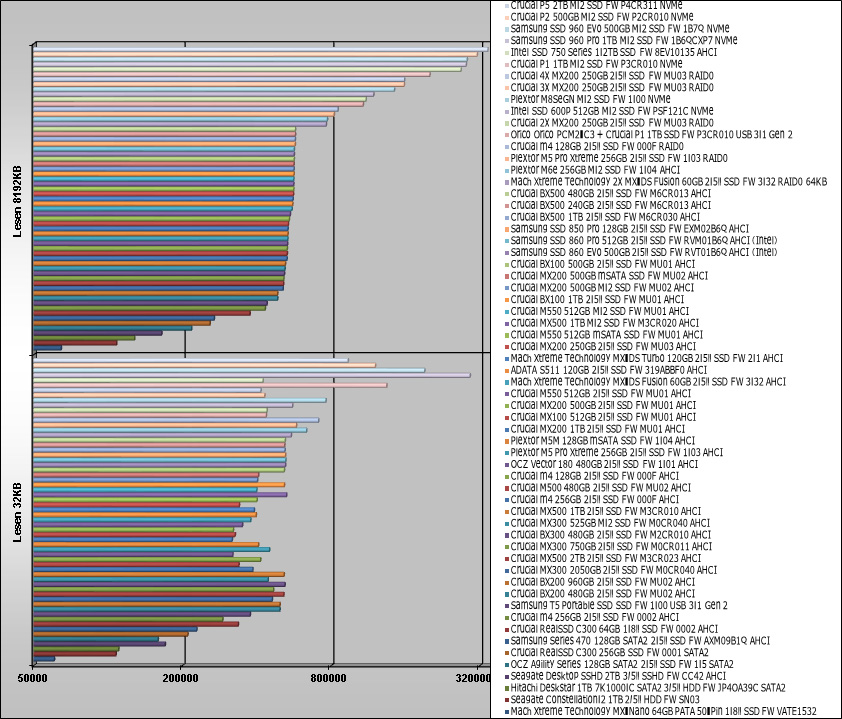
With CrystalDiskMark one receives a balanced measurement of the performance with different transfer sizes.
Here is a Snipping screenshot of the CrystalDiskMark values (SATA3):
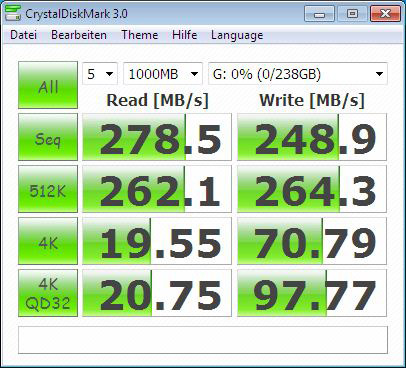
As seen in the previous 4K-64Threads results, the read and write 4K QD32 and the sequential read result is much higher when operating in AHCI mode.
Here is a Snipping screenshot of the CrystalDiskMark values (SATA3 AHCI):
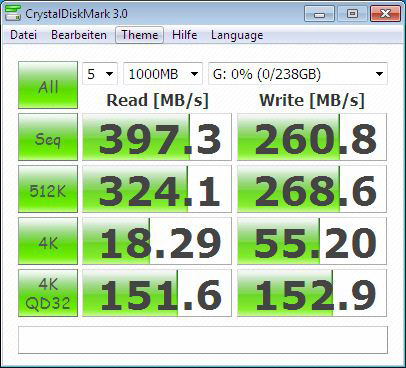
The following diagram shows the CrystalDiskMark results once again compared with other SSDs and platter drives, which are extended step by step. In the CrystalDiskMark comparison one can see significant differences between the to-date tested of the Solid State Drives and Hard Disk Drives, where the tested Crucial m4 256GB SSD or Micron RealSSD C400 256GB SSD has directly after TRIM the fastest read performance.
Here is a comparison of the CrystalDiskMark values, which are getting updated with soon coming drives:
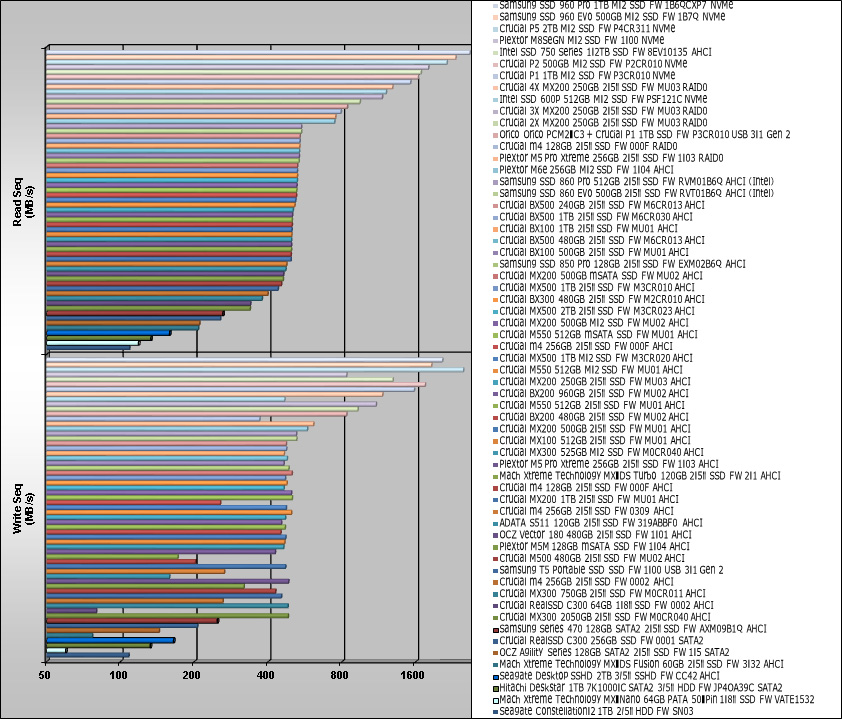
With HD Tach one can measure the gradient of the performance. The Crucial m4 256GB 2.5″ SSD shows after a TRIM no break-downs, but a very constant transfer rate with extremely low access times of approx. 0.1ms in AHCI mode. Directly after the benchmark, another benchmark in AHCI had strong read performance losses like this one. To compare these results with SATA3 IDE values, you can move the cursor over this Crucial m4 256GB SSD SATA3 IDE link. Furthermore you can move the mouse over the following drives to see their respective benchmark results:Crucial C300 64GB 1,8″ SSD at SATA3, Crucial RealSSD 256GB 2,5″ SSD at SATA3, Crucial RealSSD 256GB 2,5″ SSD at SATA2, OCZ Agility 128GB SSD, Hitachi 7K1000.C 1TB disk drive and Toshiba MK8007GAH 1.8″ disk drive.
Here is a Snipping screenhot of the HD Tach benchmark values:
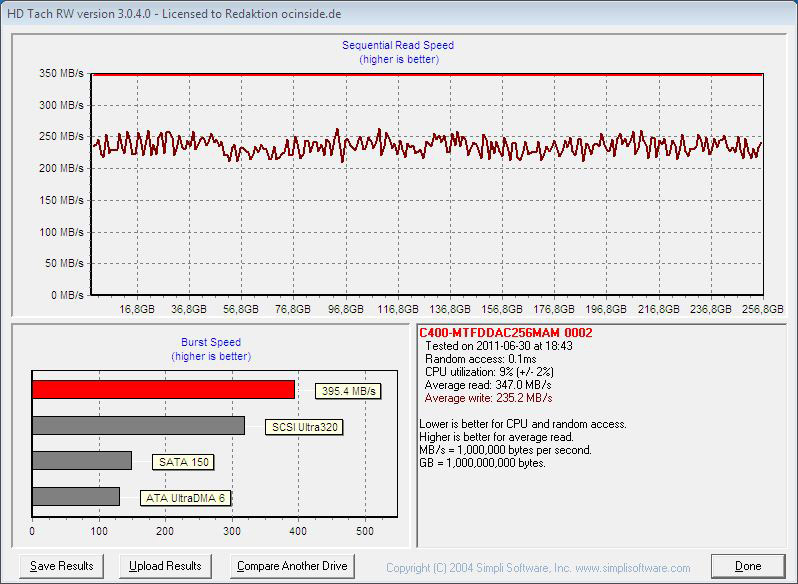
The comparison of the HD Tach benchmark results shows very impressive the fast reading speed, writing speed and the average access time of the Crucial m4 256GB 2.5-inch SSD after TRIM. The performance fall in IDE mode and directly after write cycles.
Here is an impressive comparison of the HD Tach benchmark values, which are getting updated with soon coming drives:
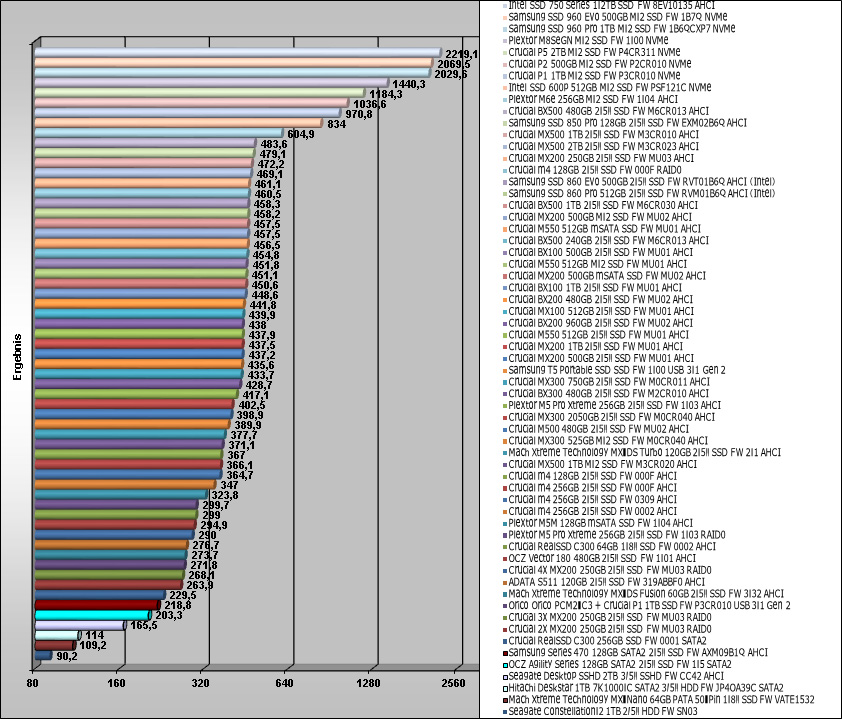
SiSoftware Sandra benchmark result
Of course, SiSoftware Sandra benchmark should not be missing in this test series. SiSoftware offers with their SiSoft Sandra program a very comprehensive tool, which contains a lot of tools to get very reliable test results of all hardware components. The average access time of the Crucial m4 256GB SSD was in SiSoftware Sandra with 50us extremly low and the drive index of 413,15 MB/s was also in IDE mode much higher than in the previous tests.
Here is a Snipping screenshot of the SiSoftware Sandra benchmark values (SATA3 IDE):

In AHCI mode SiSoftware Sandra measured 470.2 MB/s at the read performance and this is the to-date fastest result.
Here is a Snipping screenshot of the SiSoftware Sandra benchmark values (SATA3 AHCI):

Here is a comparison of the SiSoftware Sandra benchmark values, which are getting updated with soon coming drives:
